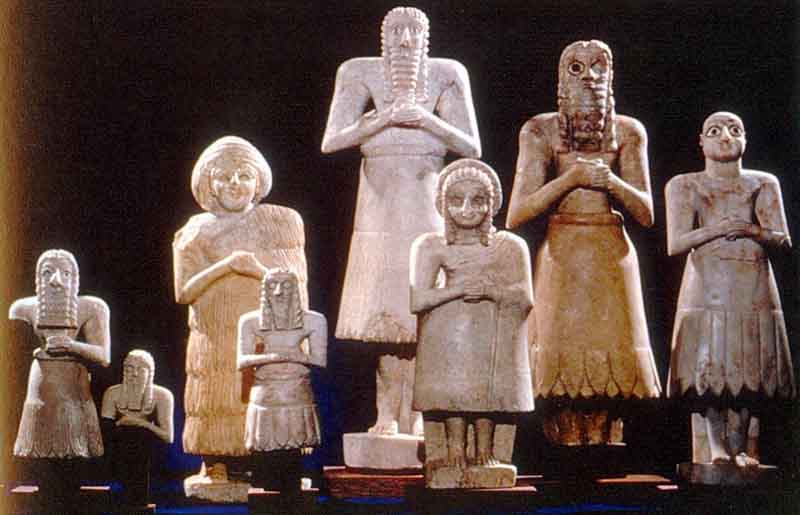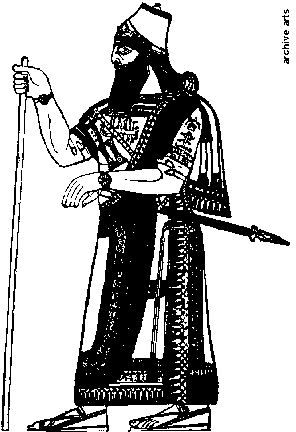Mesopotamia ~3500-600BC
Contemporary Events
- Sumerians found the first cities in southern Mesopotamia about 3500BC.
- Babylon was established by the Amorites around 2279BC.
- The Assyrian army conquered the area shortly after 1000BC.

Votive Statues, from the Temple of Abu, Tell Asmar
c.2500 BC, limestone, shell, and gypsum. http://www.crystalinks.com/sumerart.html
The Mesopotamians
The Sumerian statues above date from some time around approximately 2500 BC. They are wearing pagne and possibly little else. Originally the pagne was simply a fleece hide wrapped around the body–often with the tail still attached. A variation of the pagne (shown below) wraps around the body and then up and over the wearer’s left shoulder. Eventually (once weaving practices are discovered) tufts of wool are woven into the cloth to simulate the curling fleece fur. This variation is given the name kaunakes.

Sumarian man wearing kuanakes

Babylonian musician wearing a woven wrapped garment. http://ancientmesopotamians.com/ancient-mesopotamian-music.html
This carving on the right comes from the Late Sumerian/Babylonian period. It is dated as being created between 2000-1600BC. The man shown here is wearing the draped garment as discussed in class. This is most likely a rectangle of fabric wrapped around the body and secured as we would a towel today (with the ends tucked in) or with one or more fibulae (functional and sometimes decorative brooches).
Weaving techniques are regularly practiced during this era, and the draped garment becomes the typical male attire. Women may chose to continue to wear kaunakes during this time.

Assyrian king wearing layers of fringed shawls and tunics. http://www.biblehistory.com/ibh/Assyrian+Reliefs/Human+Forms/Assyrian+King
This image of a Late Babylonian/Assyrian man is taken from a secondary source. It is an etching taken from an artifact created during the period. This culture is marked by a much more complicated attire. Tunics (a T-Shaped garment with an opening for the head and arms) are very popular amongst this civilization. Sleeves are generally woven “in one” with the body of the garment, and simple sewing was necessary in order to close up the under arms and sides of the garment.
Noti ce the multiple layers of shawls worn by this individual. Each band of pattern represents a shawl in this image. These were often edged with fringe.
ce the multiple layers of shawls worn by this individual. Each band of pattern represents a shawl in this image. These were often edged with fringe.
More shawls=higher status. Also notice his Fez/Tarbush style hat. These often had lappets (ribbon-like streamers) that hung over each ear, which are also a sign of status and/or office. Beards are very commonin this culture, as is footwear. Sandals are very common.
The Late Babylonian/Assyrian is the most complex of the three cultures.
QUICK REVIEW
TYPE OF DRESS: draped
TEXTILES: primarily wool
SILHOUETTE SHAPE: natural hourglass
BASIC GARMENTS: Sumerians: possible loincloth, wrapped skirts; Babylonians: add wrapped dress-like garment; Assyrians: add tunics and layers of shawls.
MOTIVATIONS FOR DRESS: Status and decoration
KEY IDENTIFIERS: Sumerians: tufts of fur, very simple; Babylonians: woven cloth wrapped around the body, increase in complexity; Assyrians: tunics and fringe shawls, fez-like hats and wedge sandals.
Recent Comments